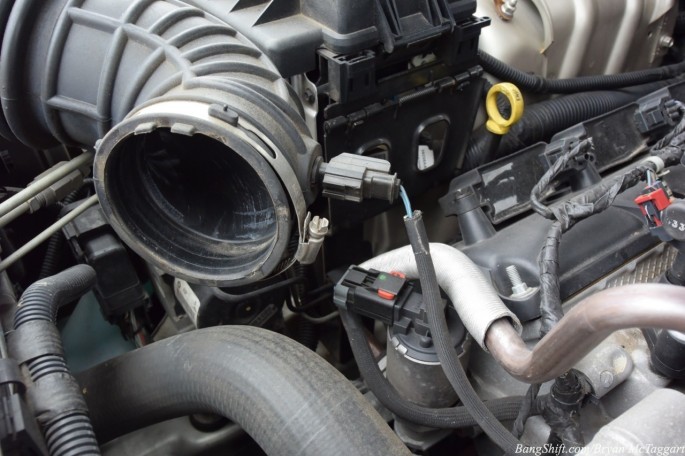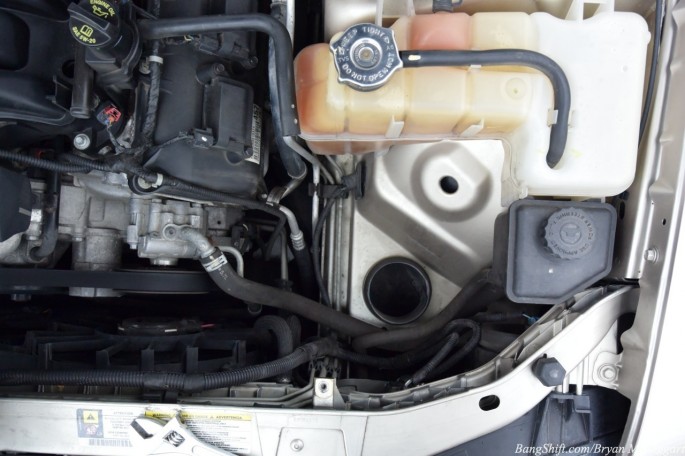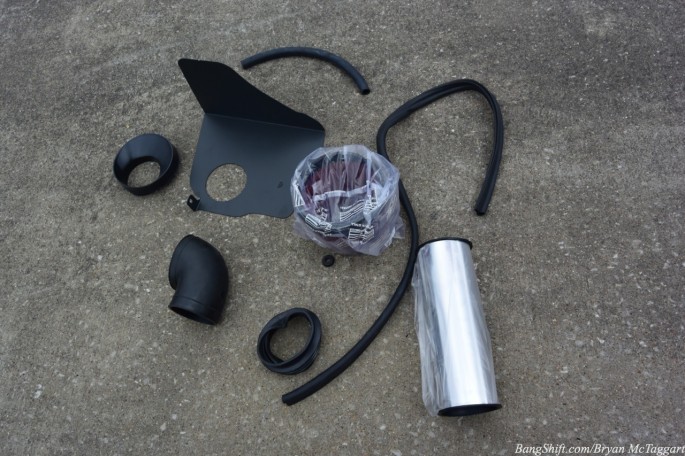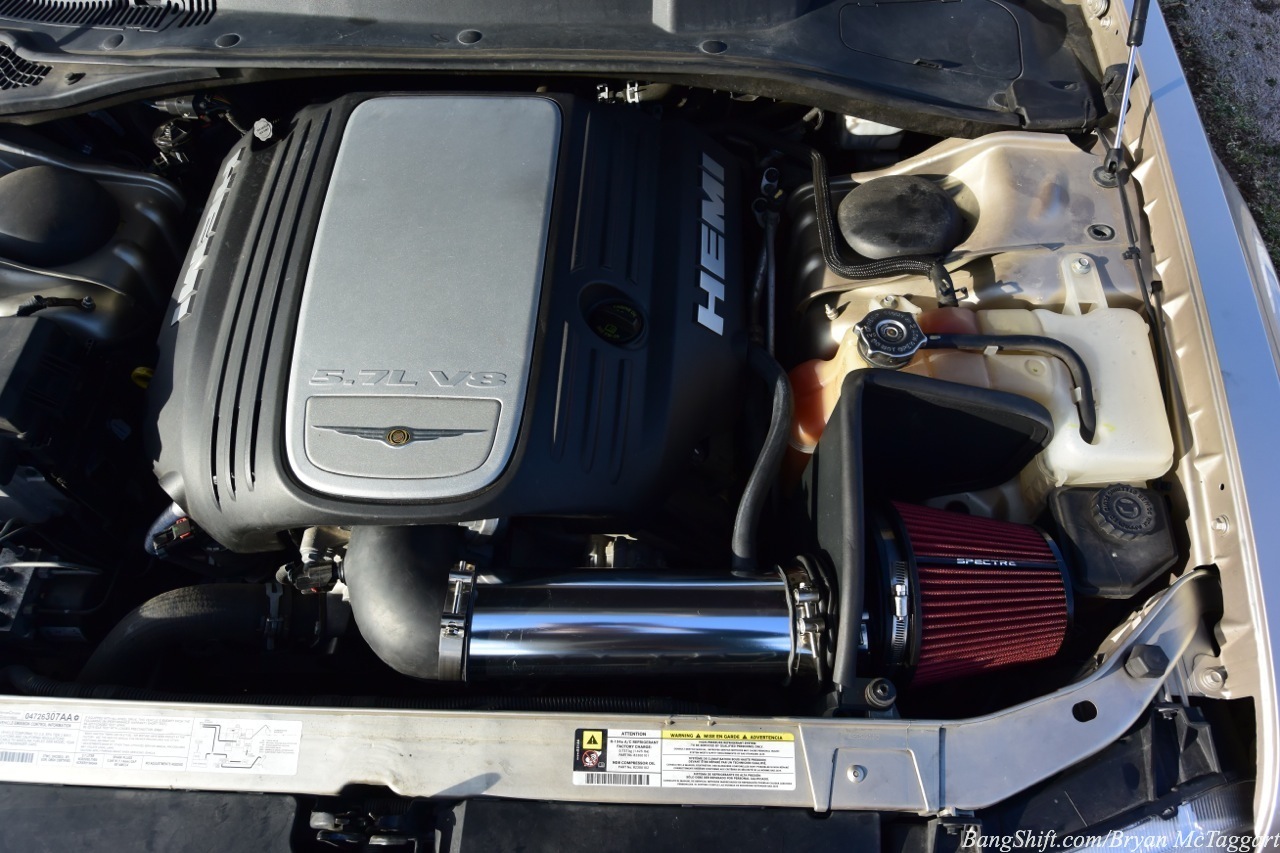In order for the 5.7 inside of our Chrysler 300C to make noise and tire smoke, the engine has to breathe, simple as that. We first started by letting it exhale better with the Magnaflow exhaust, and now we’re switching ends and focusing on the incoming air. Short of a $550 aftermarket ram-air hood, the best step that we could make was to install a cold-air intake system. I actually sat on the fence on this for a little while, because unlike most situations I’ve encountered in the past, the Mopar LX platform has a pretty decent air box setup from the factory, with plenty of airflow available. In fact, if it weren’t for the fact that it’s a closed system and it was a lot of black plastic in the engine bay absorbing all of the heat available, I wouldn’t have touched it. But since it was occupying a lot of space, we have more planned for the car and since the factory inlet tube will do a good enough job of keeping water and road debris out of the filter, we made the call and chose a Spectre system (part number 9935) and got to work. Once again, I’m pleased to say that the instructions were clear, the materials were good to work with and the kit went together fairly quickly and with no trouble.

The factory setup is actually a pretty tidy piece with a moderately sized filter. But that is a lot of black plastic that can hold a good amount of heat.

Two items are retained from the factory system: the one bolt that holds the air box onto the radiator support and the air intake temperature sensor. Take your time here…the sensor tip can break with no warning.

Once the air box is removed you can see why a cone-style filter isn’t a big worry in these cars. There’s plenty of distance between the inlet tube and where the filter will sit.

This is the entire Spectre kit. The instructions are clear and the test fit was completely uneventful, with the only struggle coming from the flexible connector (low center)

The new heat shield is much less intrusive than the air box and fit like a glove straight out of the box. It’s also tall enough that the top will seal with the hood’s insulation padding.

Once again, I remind you about the difficulty involved with the intake temperature sensor. Easily the worst part of the installation, great care must be taken in order to not break the tip. This was sensor #3. Don’t be like me.

Every part of the Spectre kit is designed for out-of-the-box use with no need for adjustments. Mocked up against the stock hose, the sensor is in the exact same location.

A conical reuseable filter is sent with the kit as well. Installation, from start to finish, takes about a half-hour. There’s still more work to go on the Chrysler before we discuss actual power gains, but one thing that certainly has changed is the intake noise. The Chrysler has gone from trying to be Mercedes quiet to sounding more like it’s NASCAR-inspired heritage should, with an aggressive and deeply throaty noise on hard acceleration. There’s a couple more pieces to the puzzle for our 300C before we learn just how well all of these individual parts work out, so stay tuned!

























Excellent How-to. Thanks for sharing your mistakes with the IAT sensor as well.
What’s your next step? And where is the video of it running so we can hear it?!
We actually did a test a few years ago on a bunch of different CAI setups. The ones with the metal intake tube were far worse then the stock ones or ones with a composite or carbon fiber tube. The metal ones heat soaked much faster, transferred the heat to the incoming air charge faster and retained that heat longer. You’ll actually lose horsepower with one over the stock or any non-metal tube CAI setup.
But it sounds better.
Heat soak is a myth. People forget to include the “boundary air layer” phenomenon in their test.
Quicky what it is is a layer of trapped air that eddies around close to the ID of ANY pipe with air flowing. This layer of air INSULATES the flowing air from external changes in temperature like from the pipe.
Another problem is the air is flowing at a rate of lets say 600 cfm through the intake so it doesn’t take a genius to figure out the the amount of time the flowing air stays in the intake is miniscule. Therefore not enough time for heat to transfer from the pipe, through the boundary air layer, and have enough time left over to actually transfer heat to the incoming charge.
I have even checked it because I have a thermometer installed into my intake and measure at the entry point of the TB.
It does get hotter after sitting at idle in traffic for 5-10 minutes BUT as soon as the vehicle starts to move the IAT temps drop rapidly. If the light changes green and you have an open road a WOT run will reduce the IAT back to ambient air temps in SECONDS because the moving air ALSO conducts heat away from the pipe.
Heat Soak is not a myth, we’ve used infared thermometers to check the temperature of the different units and had a thermometer in the tube end of the tube nearest the TB to detect variations in temperature before going into the engine.. The boundary layer does stick to the inside of the intake tube, but there is so much air flow that the layer is very thin, and with the tube absorbing so much heat, it does effect the incoming air charge.
This won’t show up on a dyno, but we drove around in a 09 SRT Challenger testing. You can google around and find the results. I think the Carbon Fiber one worked better.
Right and did you do the calculations to see how long the moving air remains in the intake and more importantly how much time the hotter pipe (which I agreed with) has to transfer any heat to that air column? I think not or you would know why there is no difference in dyno results.
The boundary layer air is always there and always has an insulating effect no matter the speed of the air column but the bottom line is the amount of time the air could be effected by the heat transfer is MINISCULE and therefore any heat transfer is negligible to the point of being unmeasurable.